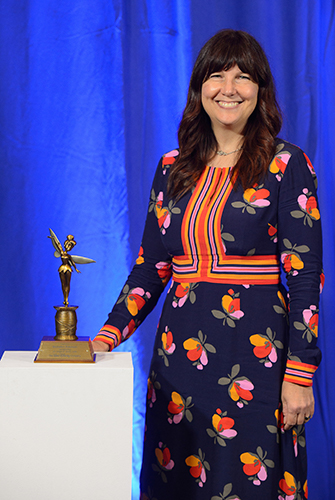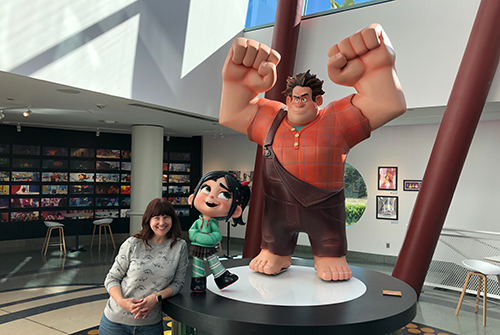 While working at Disney for 25 years, Michelle Robinson ’91 has helped shape animated films that inspire and entertain audiences around the world.
While working at Disney for 25 years, Michelle Robinson ’91 has helped shape animated films that inspire and entertain audiences around the world.
In 1989, something remarkable was happening on the second floor of the Langford Architecture Center. Computers the size of mini-fridges had been wheeled into a spacious, glass-enclosed workroom affectionately referred to as the “fish bowl”. Wide-eyed graduate students congregated around the imposing pieces of equipment ready to take their first steps into a cultural and technological frontier. The Texas A&M University Visualization Laboratory was underway.
The Visualization Laboratory, or Viz Lab, was a grand experiment within the encompassing College of Architecture, a broad academic venture that put art and computer science on a collision course. Early coverage of the program noted Texas A&M as an unlikely home for such a program, known more for its eponymous agricultural and mechanical programs than for art and design; but the draw the program had on technical and creative innovators alike quickly set it apart from the national crowd.
One of those innovators was a then-senior environmental design student, Michelle Robinson ’91, who couldn't help but slow down and peek through the windows into the lab as she traveled between classes at Langford. “I saw the first group of people in the laboratory working madly at their computers, and what they were doing looked really interesting,” she said. “It was rudimentary computer graphics, but it looked like the future.”
It was a future that she wanted to be part of. She applied to the fledgling graduate program upon receiving her bachelor’s degree in environmental design. “I thought I’d get a job at an architecture firm creating 3D models of buildings,” Robinson said. “I never considered that I might end up working at Disney.”
In the Lab
Raised in a military family, Robinson grew up moving across the country, living in Arizona, Ohio, Virginia and Arizona again before settling in Universal City, Texas, outside San Antonio. Her parents encouraged her natural ability to draw and provided her opportunities to excel throughout her young life. As early as middle school, she learned about the basic principles of art and design through private lessons and public workshops.
She chose to attend Texas A&M with the support of a President’s Endowed Scholarship courtesy of the late architect Harwood K. Smith ’35 and studied art abroad in Italy during her undergraduate studies. When she studied in the Viz Lab, it was an extremely unique program getting its legs in its infancy. “The Viz Lab at the time was a mix of computer science people and artists trying to figure everything out,” Robinson said. “It was a tight-knit group, and there was a bit of a pioneering spirit among us. There weren't a lot of instructions for what we were doing, so we worked through it all together.”
Robinson was convinced she would become an architect, a career path she thought would best utilize her artistic abilities. Midway through her time in the visualization program, however, she got other ideas. She remembers being particularly inspired to rethink her career trajectory by the computer-assisted ballroom dance scene from “Beauty and the Beast.” Robinson and a friend watched in awe as the titular main characters waltzed beneath an elaborate 3D chandelier, and she became convinced that computer-generated effects would become instrumental in the animation medium.
The equipment Robinson worked on in the Viz Lab was considerably slower and more manual compared to what students use today. “If you wanted to move a 3D object through space, you couldn't just drag it with a mouse. You had to type in the x-y-z coordinates every time,” Robinson explained.
She and other students spent long hours in the always-open laboratory, cranking out short films, lighting projects and anything else they could create with the software at hand. Robinson’s own student work was exhibited in film and art festivals across the world from Dallas and Montreal to Tokyo. The Viz program gained such notoriety within the digital industry that its faculty encountered a unique problem: Few students finished their degrees before they were lured away with fantastic job offers—Robinson included.
Robinson sent her work to Walt Disney Animation Studios and other animation companies. “Applying for animation jobs at the time meant putting my demo reel on a videotape, slipping it in an envelope with my resume, mailing it straight to each company and anxiously waiting for a phone call,” she said. Weeks after she sent her reel, Disney scheduled an interview with her. A week later, they called her again, this time offering a full-time position at their studio in Burbank, California, where she would work alongside her then-fiancé (now husband) Darrin Butts ’90, whom she met in the Viz Lab.
 Michelle Robinson ’91 currently works as a look developement supervisor at Disney. She has collaborated with and now manages artists tasked with painting digital textures, hair and fur on projects like “Meet the Robinsons,” “Bolt,” “Tangled,” “Frozen,” “Zootopia,” “Wreck-It Ralph” and “Ralph Breaks the Internet.”
Michelle Robinson ’91 currently works as a look developement supervisor at Disney. She has collaborated with and now manages artists tasked with painting digital textures, hair and fur on projects like “Meet the Robinsons,” “Bolt,” “Tangled,” “Frozen,” “Zootopia,” “Wreck-It Ralph” and “Ralph Breaks the Internet.”
Working Where the Magic Happens
Robinson arrived at Disney during a significant transition as 3D computer animation took its first steps toward dominating the animation industry. One of her first major projects was assisting the animation of “Pocahontas’” Grandmother Willow, an anthropomorphic talking tree character animated with a combination of traditional 2D elements and computer-generated 3D textures. She continued to work on a variety of 2D animated films and Disney’s first fully computer-animated feature film, “Chicken Little.”
Today, Robinson works as a look development supervisor. She has collaborated with and now manages artists tasked with painting digital textures, hair and fur on projects like “Meet the Robinsons,” “Bolt,” “Tangled,” “Frozen,” “Zootopia,” “Wreck-It Ralph” and “Ralph Breaks the Internet.” On the Oscar-winning “Zootopia," Robinson’s team created stunning photorealistic fur that could be efficiently rendered on the film’s wide array of animal characters. With Disney’s most recent film, “Ralph Breaks the Internet,” there were 434 unique characters with 6,752 variations that her team optimized to consistently fit the overall look of the film.
While admittedly, work is work and Robinson’s job is no exception, she is consistently reminded of the raw emotional weight that her films have had on audiences young and old. “This fall, I hit my 25-year work anniversary at Disney,” Robinson said. “Around the same time, I met this woman who was 25 years old, and when she found out what I do and where I work, she looked at me and said, ‘You created my childhood.’ That comment really stuck with me because…I guess it’s kind of true. It speaks to how these movies can make a difference in peoples’ lives.”
Fostering Three-Dimensional Dreams
In 2008, Robinson received an email from Tim McLaughlin ’90, a former Viz Lab student who had recently left his career at Industrial Light & Magic to return to College Station and lead the visualization program. McLaughlin asked her to join a group of industry professionals called the Visualization Industry Partners to act in an advisory role at Texas A&M. Since accepting, Robinson has taken on an active role in mentoring current Viz Lab students, visiting the program at least twice a year, consulting with prospective animators and giving in-depth critiques of students’ work over Facebook Messenger and Skype.
The Viz Lab itself continues to grow, enticing generation after generation with its wide array of computers and inviting creative spaces. What was once an experimental graduate program now offers bachelor’s degree and Master of Fine Arts and Science degree paths, allowing more ways for young digital creators to study under the nationally-recognized Department of Visualization.
When Robinson visits, she surveys the advancements the department has made between the facilities and students themselves. “I see an ease and comfort level with the technology among current students that puts them several steps ahead,” Robinson said. “Every semester, someone will show me something cool.” What hasn't changed in the Viz Lab is the pioneering spirit of wanting to push the boundaries of every tool available, to create what has never been created.
To support the College of Architecture or the Visualization Laboratory, contact Larry Zuber below.